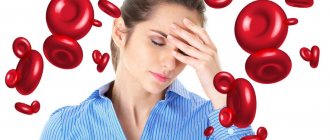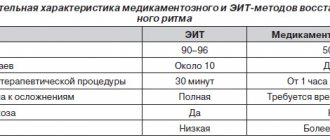When?
Inflammatory lesions of the bronchi and lungs are the most severe and cause significant intoxication of the body. Among inflammatory diseases of the bronchi, the greatest intoxication is characteristic of bronchiectasis, cystic fibrosis with symptoms of purulent bronchitis, exacerbations of COPD and bronchial asthma. Even more significant intoxication accompanies the course of infectious and inflammatory lesions of the lung tissue - pneumonia, abscess and gangrene of the lung, various forms, especially destructive ones, of pulmonary tuberculosis. Lung lesions are also common in rheumatic diseases and systemic vasculitis, in malignant tumors - lung cancer, atelectasis of pulmonary tissue, and pulmonary failure.
INTOXICATION SYNDROMES in critical care medicine and the possibility of their infusion correction.
Kharkov Medical Academy of Postgraduate Education
Summary. The article discusses modern aspects of the pathogenesis of intoxication syndromes. Pathogenetic approaches to infusion therapy of endogenous intoxication are substantiated. A critical analysis of the possibilities of extracorporeal detoxification therapy and individual infusion drugs as means for detoxification was carried out. Practical recommendations for the use of some infusion solutions with detoxification effects are presented.
Key words: detoxification, plasmapheresis, infusion therapy.
Intoxication is one of the most widely used terms in clinical practice; intoxication is encountered in a wide variety of branches of medical practice, among which, in addition to toxicology, it is necessary to mention surgery, especially purulent-septic surgery, various areas of internal medicine and pediatrics, infectious diseases and, of course, intensive care. Despite the obviousness of this pathological process, its strict scientific outlines have not been fully formulated to this day. This is due to completely objective reasons, among which it is necessary to mention: the extreme diversity of toxic factors, and, as a consequence, a large polymorphism of intoxication symptoms; complex interaction between the processes of toxin production and detoxification in the conditions of the whole organism; the dominance of nonspecific manifestations of intoxication due to the known universality of the metabolic consequences of various intoxication processes.
In this regard, it seems appropriate to highlight some of the most general provisions regarding the classification of toxins and mechanisms of intoxication. The morphological basis of intoxication is the subcellular interactions between the toxin (ligand) and the receptor, as well as subsequent changes in various intra- and extracellular regulatory molecules. The consequence of this interaction is a change in certain biochemical processes and a violation of the functional state of tissues and organs. The condition for the development of intoxication, which is understood as a dynamic process, is the dominance of the processes of toxins entering from the outside or their formation within the body over the capabilities of detoxification systems to eliminate them. Depending on the sources of toxins, intoxication is divided into:
1) exogenous;
2) endogenous;
3) endotoxicosis [1].
Toxicologists and, to a lesser extent, infectious disease specialists have to deal with exogenous intoxications when treating patients with diseases whose pathogens produce exotoxins (diphtheria, tetanus, botulism). Exogenous intoxications, as a rule, have a clearly defined clinical picture, and the best means of detoxification is the introduction of specific antidotes or toxoids.
In most other clinical situations, intoxication syndrome is caused by the accumulation of:
- bacterial endotoxins (lipopolysaccharide) and other bacterial modulins (teichoic acids, peptidoglycan, mannose, etc.), which are the primary biochemical substrate of endotoxicosis;
- toxic organic compounds (mercaptan, ammonia, indole, skatole, false neurotransmitters);
- excess amounts of physiological products of interstitial metabolism and metabolism (ketone bodies, urea, creatinine, uric acid, bilirubin, lactic acid, etc.);
- biologically active substances and mediators (interleukins, interferons, tumor necrosis factor and other mediators of the systemic inflammatory response, eicosanoids, kinins, serotonin, biogenic amines, etc.).
In addition to these toxic factors, developing water-electrolyte, osmotic and acid-base disorders undoubtedly influence the formation of intoxication syndrome and its clinical manifestations. I would like to note that the manifestations of these disorders are often very similar to the symptoms of endotoxemia, and can, to some extent, determine the severity of this symptom complex.
From a practical point of view, it is very important to know the size of toxin molecules, as well as the strength of their binding to carrier proteins. In accordance with this, a distinction is made between toxins with molecules less than 150 nm in size, which are predominantly of dismetabolic origin, from 150 to 250 nm, which are of para-infectious origin (lipopolysaccharide) and xenobiotics, and toxin molecules with a size greater than 250 nm, formed as a result of resorption products of cellular destruction. According to available data, toxins of parainfectious origin quite often do not have a strong connection with carrier proteins (albumin and globulin fractions of plasma), and large-molecular toxins formed during cellular destruction have a highly strong connection with toxin-carrying plasma fractions [2].
Equally important for practice is an understanding of detoxification pathways. The most well-known detoxification routes are:
- metabolic mechanisms (utilization of ketone bodies);
- excretory mechanisms (excretion with urine, exhaled air and contents of the gastrointestinal tract);
- immune mechanisms (absorption of toxins by cells of the monocyte-macrophage system, binding by neutralizing antibodies, etc.)
Given the potentially fatal results of progressive intoxication, detoxification has been and remains one of the mainstays of intensive care. In the minds of most clinicians, a strong belief has taken root in the detoxification capabilities of infusion therapy, which, unlike extracorporeal detoxification methods, is easily feasible and therefore widely used in all medical institutions. Meanwhile, infusion detoxification can be effective only if its capabilities are used correctly, which requires knowledge of the pharmacodynamics of infusion drugs. There are several “myths” associated with infusion therapy, and it is necessary to understand what is fiction and what is reality.
Myth one.
Infusion therapy always has a detoxifying effect.
It is obvious that the detoxification effect of infusion therapy is possible only in cases where there are prerequisites for enhancing the natural pathways of detoxification with the help of the administered infusion drug. This is possible only in cases where the toxin does not have a strong connection with carrier proteins or receptor molecules and can overcome the renal barrier, i.e. excreted from the body with increased diuresis. It is in such cases that infusion detoxification, called forced diuresis, has become most widespread in toxicological practice. In other cases, when carrying out infusion therapy, one has to rely only on the dilution effect and, as a result, a decrease in the concentration of toxic compounds. However, keeping in mind the fact that the volume of the interstitial sector in adults is 15-16% of body weight (about 10 liters), and plasma - 4-5% of body weight (about 3 liters), in order to reduce the concentration of dissolved toxins doubled, it is necessary to introduce and retain about 13 liters of fluid in the patient’s body, which will inevitably lead to the development of edema. Obviously, the benefits of such “detoxification” are more than doubtful. Despite these obvious arguments that reflect the scope of infusion detoxification, another myth has emerged regarding the capabilities of infusion therapy.
Myth two.
There are special “detoxification solutions”.
Hemodez, Neohemodez, Gluconeodez are low-molecular solutions that, in accordance with existing instructions, are capable of binding and removing various toxic compounds in the urine. Unfortunately, all efforts aimed at establishing scientific primary sources that could confirm the information did not lead to the desired goal. Such data is simply not available. At the same time, the negative properties of these so-called detoxification solutions are well known: with repeated administration, Hemodez is known to inhibit the function of the reticuloendothelial system (RES) of the liver, since polyvinylpyrrolidone particles accumulate in its cells, blocking their phagocytic activity. Repeated infusions of Hemodez inevitably lead to the development of iatrogenic thesaurismosis (Dupont-Lachapelle disease). This phenomenon is especially pronounced in newborns and young children.
It is not surprising that in 1958 the use of polyvinylpyrrolidone derivatives was banned in the United States, and starting from the second half of the 1970s, the mention of polyvinylpyrrolidone derivatives finally disappeared from the pages of foreign medical literature.
Myth three.
Solutions of polyvinylpyrrolidone are indispensable for detoxification infusion therapy.
Let's try to refute this myth. Considering the mechanisms of endotoxin formation and detoxification pathways outlined at the beginning of the article, it seems logical to assume that an infusion solution capable of having a detoxification effect should:
■ optimize tissue perfusion in order to improve conditions for the diffusion of toxic factors from affected cells, tissues and organs into the general bloodstream;
■ cause hemodilution, accompanied by a decrease in the concentration of toxins in the blood plasma;
■ force diuresis, as a result of which toxins and metabolites that can cross the blood-renal barrier are eliminated from the body;
■ maintain the functional state of hepatocytes, which are the most important part of metabolic detoxification;
■ eliminate the consequences of intoxication syndrome (metabolic acidosis, diselectrolyte disorders and metabolic disorders).
The detoxification effect of infusion therapy is possible only in cases where there are prerequisites for enhancing natural detoxification pathways with the help of the administered infusion drug.
A new opportunity for intensive therapy for intoxication syndrome was opened by the appearance of the innovative drug Reosorbilact® . A special feature of this drug is its balanced composition of potassium, calcium and magnesium, which contains excess sodium in the form of two salts - chloride and lactate. Obviously, the sodium alone in this preparation provides an osmolality of about 600 mOsmol/kg, which makes Rheosorbilact® very similar to the hypertonic Ringer-lactate solution that was used to combat burn shock in the 1970-1980s.
The main difference is that Reosorbilact® has a significantly greater alkalizing ability, provided by sodium lactate, which is almost 6 times more than in the ringer-lactate solution. Sodium lactate, metabolized in the liver and kidneys, forms bicarbonate ion, increases the level of actual bicarbonate in the blood plasma, and corrects metabolic acidosis. The second feature of Reosorbilact® is the inclusion of magnesium ions in its composition, which allows us to count on some positive effects of this electrolyte on neuromuscular excitability and smooth muscle tone. In addition, Reosorbilact® contains sorbitol in isotonic concentration (60 g/l).
Together with sodium, sorbitol provides a theoretical osmolarity of Reosorbilact® of about 900 mOsmol/kg, which is 3 times higher than plasma osmolarity.
The comparative composition of infusion solutions with detoxification effects is presented in the table.
Due to its high osmolarity, Reosorbilact® causes fluid to flow from the intercellular space into the vascular bed, which improves microcirculation and tissue perfusion, which solves the first problem of detoxification therapy. The movement of fluid from the intercellular sector into the intravascular space leads to an increase in the volume of circulating blood due to an increase in plasma volume, which is accompanied by hemodilution. Thus, the interstitial space is “drained” and freed from toxic factors. Due to the powerful osmodiuretic effect of sorbitol and sodium in hypertonic concentrations, a pronounced diuretic effect of the drug is noted. It is significant that Reosorbilact® also has a nephroprotective effect, and also increases diuresis even in the presence of acute renal failure. Consequently, toxins that can cross the renal barrier are intensively eliminated from the body. In addition, sorbitol, metabolized to fructose, normalizes carbohydrate and energy metabolism. This has a beneficial effect on the functional state of hepatocytes, in which glycogen reserves are restored, which is an obvious contribution to the intensification of natural detoxification processes.
Sodium lactate contained in Reosorbilact® helps to correct the acid-base state, and also, by participating in the reactions of carbohydrate-energy metabolism, restores and stimulates the functions of the liver and kidney RES cells. The presented theoretical ideas about the possible detoxification activity of Reosorbilact® have found convincing clinical and experimental confirmation. Studies conducted by domestic clinicians indicate that in patients with endogenous intoxication due to chronic inflammatory diseases of the respiratory tract, the use of Reosorbilact® provided an earlier and more significant detoxification effect than Hemodez infusion. This was expressed in a significantly greater decrease in leukocytosis, indicators of average blood mass molecules and malondialdehyde. To summarize, I would like to emphasize that clinical practice requires a rethinking of existing ideas about detoxification infusion therapy. It is obvious that the rejection of the stereotypical idea of a detoxification solution only as a drug that binds and removes certain toxic substances with urine will help expand knowledge about the pathogenetic mechanisms and methods of detoxification, as well as the introduction into clinical practice of other, more substantiated and multifunctional means of infusion detoxification.
Treatment:
The effectiveness of treatment measures depends on the accuracy of the diagnosis. The doctor can select an individual treatment program based on the results of laboratory tests, diagnosis and severity of the disease. The doctor may prescribe antipyretic, immunomodulatory, anti-inflammatory, antiviral drugs, as well as physical therapy, diet, infusion therapy, and vitamin therapy.
Contact the Multidisciplinary Pulmonology Center for help from competent specialists.








